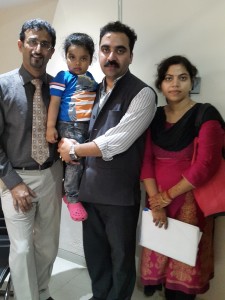Hypospadias remains the most common urological anomaly in boys and more than 1 lakh kids are born in India every year with Hypospadias. Majority of these are mild variety like glanular, coronal, distal penile or midpenile hypospadias. Less than 15% of all hypospadias are moderate to severe variety of hypospadias like proximal penile, penoscrotal or scrotal hypospadias. While very mild hypospadias like glanular or coronal without chordee may be left alone without surgery, all other types of hypospadias or those with chordee require hypospadias correction treatment.
There are more than 100 different types of hypospadias surgery techniques described in medical literature attesting to the fact that none of the techniques are perfect or suitable for all types of hypospadias. The hypospadias specialist surgeon needs to be well acquainted with anatomy and various techniques to decide the type of surgery needed in a particular hypospadias case. Subtle variations in anatomy decide the type of technique needed. Hence the decision for each hypospadias is very individualized.
The common techniques in use for primary hypospadias are TIP urethroplasty (Snodgrass repair), Mathieu repair, Onlay Island flap urethroplasty, Prepucial tube and staged Bracka’s urethroplasty. Each technique of hypospadias surgery has its own advantages and disadvantages and case selection becomes very important.
Case: Boy from Lucknow
Master A.C. was born with proximal penile hypospadias in Lucknow. He was advised surgery after one year of age by the doctors in Lucknow. They consulted various surgeons in Lucknow and Delhi but were not satisfied by the approach. Finally, the boy’s uncle who was a scientist in CSIR sent an email to Hypospadias Foundation with all records and pictures asking for an opinion. We advised a clinical examination and a single stage surgery. The family flew to Mumbai and saw us in MITR Hospital, Kharghar where Hypospadias Foundation is located. The penis size for Master A.C. was very small with a stretched penile length of 2 cm and Glans diameter of 11mm. We advised two injections of Testosterone (male hormone) to induce growth of penis at one month interval. After one month of second injection, the glans size increased to 15.5 mm and penis length to 29mm. At this time, we planned a hypospadias correction surgery. A.C. was admitted the morning of surgery and a single stage urethroplasty was done using Onlay Island Flap technique for which Dr Singal is very renowned. The surgery took 90 minutes and the boy was discharged the next morning after hypospadias surgery. The dressing was removed after 5 days and catheter was removed after 10 days. A.C. passed urine well and at one month follow-up was passing urine in a good stream without any issues. The penis has healed very well with an excellent cosmetic result. The parents were overjoyed and sent an email of thanks after one month from Lucknow. Further follow-ups will be via email and phone calls. Patients from across the globe follow-up with us using electronic medium such as email, whats app and skype.

Dr Singal with Family from Lucknow
Testosterone (hormone) injection before Hypospadias surgery
In some cases of hypospadias the penile size may be small and the head of penis (glans) may be very tiny. In such cases it is difficult to repair the hypospadias adequately. We advise testosterone injections in dose of 25mg intramuscular injections two months and one month before surgery. The testosterone injections help in two ways: Increasing the size of penis and glans; secondly the blood supply (vascularity) of the foreskin increases which helps in making a good flap in severe hypospadias. Two doses of testosterone injections do not have any short term or long term side effects on body growth etc. Part of the effect of testosterone on penile growth is reversible but part increase in size of penis is permanent. For us at Hypospadias foundation, we give Testosterone injections for babies where the penis size is less than 25mm or the glans diameter is less than 13-14mm.
Onlay Island flap urethroplasty
Onlay island flap urethroplasty is a type of hypospadias repair surgery where a flap is made from foreskin on the top of penis (dorsal prepuce) and brought on underside of penis. This flap is based on a robust blood supply from dartos tissue of the foreskin (see the video below). Onlay island flap urethroplasty is reserved for severe hypospadias or where the TIP repair is not suitable and the chordee is not very severe. In hands of expert hypospadias surgeons, Onlay Island flap urethroplasty offers best results in repair of severe hypospadias. Dr A.K.Singal is one of the best hypospadias surgeon specialists in India for such surgeries. Dr Singal has been invited at various national and international conferences to showcase his surgical technique (see video below). Every year more than 200 children and adults with primary or failed hypospadias are operated under his team’s care in Navi Mumbai, India.
If your child has a hypospadias and you wish to get in touch with Dr Singal for treatment, you can fill up the contact form below or you can see him at one of his hypospadias clinics in Navi Mumbai or Mumbai. You can also call up Dr Rajkumar, Co-ordinator for Hypospadias Foundation at +91-9821261448 between 9am-6pm to discuss any queries.
Dr Singal’s clinics and Timings
Contact form for Dr Singal & Hypospadias Foundation
See Video of Proximal penile hypospadias repair using Onlay Island flap technique- by Dr A.K.Singal
See Scrotal Hypospadias repair using Onlay Island flap urethroplasty- by Dr A.K.Singal
Contact Form for Hypospadias Foundation
Please fill all clinical details and upload pictures and clinical summaries (if available)
